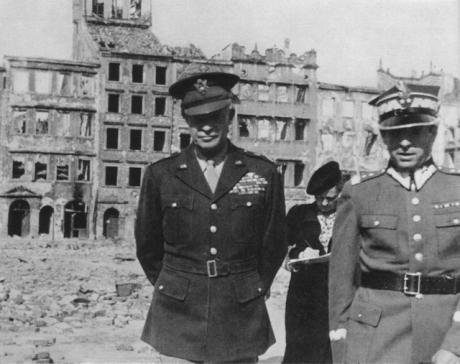
General Dwight Eisenhower – picture taken on Warsaw's Old Town Square, destroyed in 1944 by German forces after supression of Warsaw Uprising, September 1945. Right, General Marian Spychalski. Wikicommons/ Central Photographic Agency Warsaw. Some rights reserved.
General Dwight D Eisenhower was the supreme Allied commander of the armed forces in western Europe at the end of the second world war, and later served two terms of office as United States president from 1952-1960. As a former soldier and Republican he surprised many people in his final address to Congress on 17 January 1961 by highlighting the dangers of too much influence lying with the military. He was genuinely concerned about what he called the “military-industrial complex”, and his speech did much to popularise the subsequent use of that phrase and analysis of the underlying idea.
That military-industrial complex is every bit as strong today as it was in Eisenhower’s time, perhaps even stronger. In this context, one of the best informed campaign groups on these issues in the UK is the Campaign Against Arms Trade (CAAT). While it concentrates on the arms sales which form one part of the complex, much of its reporting is informative on wider issues. Its current bulletin, for example, includes these two items:
* “In February 2018, German prosecutors ordered Airbus to pay $99 million to settle one of two investigations into alleged corruption surrounding the 2003 sale of Eurofighter aircraft to Austria – Reuters, 09/02/18”
* “In January 2018, the Serious Fraud Office launched a criminal investigation into alleged money laundering, bribery and corruption at Chemring, a UK-based arms company that specialises in producing ammunition and explosive weapons – Guardian 18/01/18”.
The first is a legal decision, a sizeable fine for one of the world’s largest arms companies concerning alleged corruption, while the second is just a current investigation. But each in its own way underscores the relevance of getting to grips with the wider issue of military industries.
The point is reinforced by another item in the CAAT Bulletin, which reports on the cost of visits by British parliamentarians to arms-importing countries sponsored and paid for by the governments concerned:
“New research from CAAT shows that over the last five years, MPs have enjoyed almost £700,000 worth of luxury flights and hotels paid for by regimes with appalling human rights records. House of Commons figures, compiled by CAAT, show that MPs have had lavish international trips paid for by the governments of Saudi Arabia, United Arab Emirates, Bahrain, Qatar, Azerbaijan, Pakistan, Egypt, Kazakhstan and Oman. By far the largest spender was the Saudi dictatorship. MPs from all parties have taken part, although more than 80 per cent of those participating in the tours were from the Conservative Party.”
The working of a complex
In many ways Eisenhower’s military-industrial complex might better be termed a “military-industrial-academic-bureaucratic complex”. The longer version more fully describes the pervasive nature of the system: a military development and production complex that is sufficiently integrated and powerful to have considerable influence in determining international security policy. It embodies an outlook that prioritises violent responses to perceived threats, and contains elements that have evolved over centuries.
This complex was hugely boosted by the mass-production techniques that came to the fore in the second world war, and in massive individual projects such as the Manhattan Project that produced the first atomic bomb. At the core of the complex is a largely self-sustaining system demonstrating a high degree of integration between manufacturers, the military and political leaderships, all benefiting from security policies predicated on the potential and actual use of force.
As well as manufacturers and the military, it involves universities, research institutes, security and intelligence agencies and government ministries. All of these constitute bureaucracies that gain financial resources which are frequently based on raised perceptions of external threats that require capabilities based specifically on military force.
The complex in any one country or alliance is largely self-supporting and self-sustaining, with high levels of component interaction. Thus many academic centres will be largely staffed by former military personnel; significant income streams will come from government and arms companies; and many of the students will be from military backgrounds.
Furthermore, senior military and civil servants will commonly be recruited as consultants by arms companies when they retire, especially if they have worked in areas of weapons development and procurement. They may also link with security think-tanks that are largely funded from industry and government departments. This “revolving door” is a common feature in most countries, the invariable consequence being to place a premium on military capabilities in any assessment of responses to security challenges.
The power of a system
Five additional features of the complex are relevant.
First, it often depends very heavily on arms exports, but these are dependent on potential buyers seeing threats to their own security – to the extent that arms companies are all too ready to exaggerate those threats, either in their own marketing processes or by funding appropriately orientated research in think-tanks and academic centres. States with thriving arms industries will provide diplomatic and other support for arms sales, mount exhibitions, facilitate travel, and provide intelligence. There is also a widespread problem of bribery and corruption in the system, even if this is commonly masked through the use of local “agents” who open the necessary doors and use their “commission” to good effect.
Second, the complex must demonstrate “need”, so that if an arms company sees one of its weapon systems used in a war it will publicise that through the industry and in the defence and security journals, not infrequently under the heading “combat proven”. For example, this week the new Lockheed Martin F-35 multirole aircraft made its “combat debut” with the Israeli airforce in an attack in Syria, the news being published in the online version of Defense News in an item sponsored by another defence contractor, Honeywell (see Joe Pappalardo, "The Showdown Between the F-35 and the Russian Weapons Built to Stop It Is Finally Here", Popular Mechanics, 23 May 2018).
Third, one of the trends of the past two decades has been for the privatisation of many elements of the security system, especially the growth of private military and security companies. They may frequently be employed in areas of recent or evolving conflict where they are less accountable than the formal military, and they also have the advantage for the employing state that casualties attract little media attention (see "Every casualty: the human face of war", 15 September 2011).
Fourth, arms companies will frequently be supported by relevant trade unions in maintaining their lobbying potential, especially in relation to politicians with arms companies in their constituencies. Occasionally, unions will be involved in developing programmes for arms conversion, the Lucas Aerospace combine shop-stewards' committee in the 1970s being a notable example But current thinking on the issue, in the UK at least, is relatively rare, albeit with some notable exceptions such as the work of Steven Schofield.
Fifth, a further relevant development has been the progressive merging and consolidation of the world’s arms companies into a handful of very large transnational corporations. These have large and very well-funded lobbying systems, and their consolidation increasingly limits competition. There may in future be just a single corporation with the capacity to build aircraft-carriers or nuclear-missile submarines: this, combined with the revolving door, would ensure that costs persistently spiral out of control, so much so that price inflation becomes the norm (see "Britain's military: costs of failure, symbols of vanity", 26 January 2018).
If all this is put together, the sheer momentum and power of the entire system becomes clear. Whether it can ever be made accountable and democratically controlled is highly questionable, but that is far more likely to happen if it is part of a much wider process of challenging the present approach to security. There are signs that this is happening, in initiatives such as Rethinking Security and the Oxford Research Group. With but a tiny proportion of the resources the military system has available, forward looking groups of this kind play a vital role.
Read more
Get our weekly email





Comments
We encourage anyone to comment, please consult the oD commenting guidelines if you have any questions.